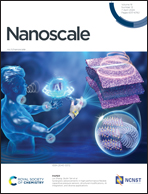From sensing interactions to controlling the interactions: a novel approach to obtain biological transistors for specific and label-free immunosensing†
Abstract
Antibody–antigen interactions are shaped by the solution pH level, ionic strength, and electric fields, if present. In biological field-effect transistors (BioFETs), the interactions take place at the sensing area in which the pH level, ionic strength and electric fields are determined by the Poisson–Boltzmann equation and the boundary conditions at the solid–solution interface and the potential applied at the solution electrode. The present study demonstrates how a BioFET solution electrode potential affects the sensing area double layer pH level, ionic strength, and electric fields and in this way shapes the biological interactions at the sensing area. We refer to this as ‘active sensing’. To this end, we employed the meta-nano-channel (MNC) BioFET and demonstrate how the solution electrode can determine the antibody–antigen equilibrium constant and allows the control and tuning of the sensing performance in terms of the dynamic range and limit-of-detection. In the current work, we employed this method to demonstrate the specific and label-free sensing of Alpha-Fetoprotein (AFP) molecules from 0.5 μL drops of 1 : 100 diluted serum. AFP was measured during pregnancy as part of the prenatal screening program for fetal anomalies, chromosomal abnormalities, and abnormal placentation. We demonstrate AFP sensing with a limit-of-detection of 10.5 aM and a dynamic range of 6 orders of magnitude in concentration. Extensive control measurements are reported.



 Please wait while we load your content...
Please wait while we load your content...